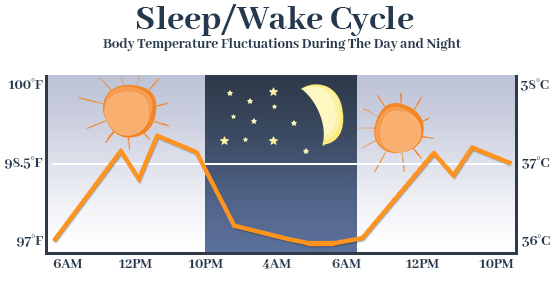Both your body and room temperature can play a crucial role in the quality of your sleep, and we’ve done the research to show you how to find the right balance.
We’ll walk you through the ideal bedroom temperatures for different age groups and show you how to achieve that “perfect” temperature and improve your sleep health.
The Best Temperature for Sleep
| Age | Fahrenheit | Celsius |
|---|---|---|
| 60-67 degrees | 15-19 degrees | |
| 65-70 degrees | 18-21 degrees |
For most adults, the best temperature for sleep is 60 to 67 degrees Fahrenheit1 (15 to 19 degrees Celsius).
The best temperature for a baby’s room should be slightly warmer, around 65 to 70 degrees Fahrenheit (18 to 21 degrees Celsius).1
However, this will also depend on personal preferences. Some people naturally sleep hot, and others sleep cold, so it’s perfectly normal to go below or above these recommended numbers to what makes you feel most comfortable.
How Does the Ideal Sleep Temperature Change as We Age?
You’ll notice in the above table that babies and toddlers are recommended to have a slightly higher and more narrow temperature range for sleep than adults. Babies cannot adapt to temperature changes as well as adults2, and they can lose their body heat up to four times faster. By allowing babies to remain at a comfortable temperature, they can conserve their energy, which is especially important if they’re battling an illness or are premature.2
While adults can adapt to temperature changes better and sleep in slightly cooler environments, newer research suggests that older adults, specifically, may benefit from a slightly warmer temperature. In the longitudinal study3, it was found that older adults had more efficient and restful sleep when the temperature was between 20 degrees Celsius (68 degrees Fahrenheit) and 25 degrees Celsius (77 degrees Fahrenheit).
Achieving the Best Temperature for Sleep
How to Keep Your Bedroom Cool
If your bedroom feels too warm for you to sleep well, there are steps you can take to help bring down the temperature.
- Close the blinds during the day – Keeping the hot sunlight out of your room during the day should help it stay cooler overall. This is especially important for those who work overnight and need to sleep during daylight hours.
- Adjust the windows according to the outside temperature – If it’s hot outside, leave the windows closed to keep the warm air out of the room. Conversely, if it’s cooler outside, open your windows to let the breeze in.
- Sleep at the lowest level – Heat rises, so if you live in a multi-story home, try sleeping on the bottom floor.
- Use a fan – You can use a fan to keep the air circulating, but make sure it’s not pointing directly at your body since this could result in sore muscles and headaches.
How to Regulate Your Temperature for Sleep
Just like it’s important to regulate your room temperature for a good night’s sleep, it’s also important to keep your body cool. This is because a drop in core temperature at night signals your body it’s time to sleep4.
Below are some ways you can cool your core temperature before and during sleep.
Use cooling bedding and accessories – Temperature-regulating sheets and pillows, as well as a good cooling mattress, can help you stay comfortable. However, different mattress types and materials have varying thermal properties. Memory foam mattresses typically sleep much hotter since this type of foam traps heat (unless they contain cooling gels), while hybrid beds or innerspring mattresses usually fare better due to improved airflow from the coils.
Sleep in breathable pajamas – Look for pajamas made with cooler fabrics like cotton, linen, and bamboo.
Avoid vigorous exercise just before bed – Exercise increases your body temperature5, and according to research6, vigorous exercise within one hour before bed could impact the time it takes to fall asleep. Instead, try working out earlier to improve your sleep.
Take a warm shower – This might seem counterintuitive, but taking a warm shower or bath7 one to two hours before bedtime can actually help lower your core temperature and improve sleep. Learn more about showering before bed and its impact here.
Limit screen time – Our phones, tablets, computers, and televisions emit a blue light that inhibits the production of melatonin8, an important hormone for sleep. Further, melatonin production is correlated with decreased body temperature at night to help facilitate sleep.4, 8 It is recommended that screens be turned off 1-2 hours before bed9.
Learn more: Best Cooling Mattress
How to Maintain The Best Sleep Temperature During The Winter
During winter, especially in northern states where temperatures get near or below freezing, you may need to keep the room slightly warmer to accommodate the significant nighttime temperature drops. Like the other seasons, the ideal sleep temperature in winter for adults is 60-67 degrees.
Some people may find it harder to fall asleep during winter, especially if they tend to run cold, so here are a few tips to help keep warm:
- Layer up – Wearing multiple layers is a simple and effective way to keep your body warm during winter. You should also consider the fabric of your pajamas since some materials are naturally cooling and may not be the best for the winter. In this case, look for fleece or wool pajamas for extra warmth.
- Use extra blankets – Placing an extra blanket or two over you at night should help you warm up quickly. You might also consider investing in an electric blanket, which is a blanket that contains an electric heater inside of it. However, we recommend checking with your doctor before using one since they may not be safe for everyone.
- Wear socks – We lose a lot of heat through the feet, which means keeping them insulated can help lock in warmth. Thicker wool socks can be great for cold winter nights.
- Use a hot water bottle – A hot water bottle can make your bed warm within minutes. You can use it to warm your feet, stomach, or any other area where you feel cold.
- Drink hot tea – Having hot tea before bed can warm you up and help you wind down.
- Invite your pet to bed – While not everyone likes to sleep with their pet, they can be sources of heat if you’re experiencing a power outage or freezing temperatures during the winter months.
How Temperature Affects Sleep
Body Temperature

As mentioned, core body temperature plays a role in sleep. Normally, a person’s body temperature fluctuates during the day but only by 1 or 2 degrees10. This is known as thermoregulation11, the body’s ability to maintain a certain internal temperature.
Our body temperature drops around two hours12 before bedtime to help facilitate sleep. The circadian rhythm, our body’s internal clock, controls these temperature fluctuations, among many other important physiological patterns.
Research has found, though, that as we age, our thermoregulation abilities aren’t as strong13. Thermoregulation is important for sleep onset, and with many adults reporting worse sleep14 as they get older, there may be a connection. This is also why the elderly are considered more vulnerable when it’s extremely hot or cold out.13
That being said, it’s important to note that while diminished thermoregulation may play a role in sleep worsening with age, there are other causes of sleep problems in older adults, including an increased prevalence of sleep disorders15.
Sleep Temperature FAQs
Is 72 degrees a good sleeping temperature?
72 degrees may be slightly too warm for babies and adults, but it may be a good temperature for some older adults.1, 3 Since the temperature is especially important for babies’ health, you can also check with their pediatrician for additional guidance.
Why is sleeping in a cold room better?
Sleeping in a cooler room is better because it can help support sleep onset. Our body helps prepare itself for sleep by dropping our core temperature roughly two hours before bed.12If your room is too hot, though, it not only feels uncomfortable but can hinder our natural thermoregulation process.
Last Word of Advice
While an ideal room temperature is helpful for sleep, it’s one of many ways you can improve your sleep quality. Practicing good sleep hygiene, investing in quality bedding and the best mattress, and consulting health professionals for more serious conditions affecting your sleep will also be important steps toward more restful nights.

Jill Zwarensteyn
Editor
About Author
Jill Zwarensteyn is the Senior Editor for Sleep Advisor and a certified sleep science coach. She is enthusiastic about providing helpful and engaging information on all things sleep and wellness.
Combination Sleeper
Education & Credentials
- Certified Sleep Science Coach
References:
- “What’s the Best Temperature for Sleep?”. Cleveland Clinic. 2021.
- “Warmth and Temperature Regulation”. Children’s Hospital of Philadelphia. Webpage accessed April 25, 2024.
- Baniassadi, Amir., et al. “Nighttime ambient temperature and sleep in community-dwelling older adults”. Science of the Total Environment. 2023.
- Harding, Edward C., Franks, Nicholas P., Wisden, William. “The Temperature Dependence of Sleep”. Frontiers in Neuroscience. 2019.
- Damatto, Ricardo Luiz., Mariano Cezar, Marcelo Diarcadia., Portugal dos Santos, Priscila. “Control of Body Temperature during Physical Exercise”. Journal of Brasilian Society of Cardiology. 2019.
- Stutz, Jan., Eiholzer, Remo., Spengler, Christina M. “Effects of Evening Exercise on Sleep in Healthy Participants: A Systematic Review and Meta-Analysis”. Sports Medicine. 2019.
- Haghayegh, Shahab., et al., “Before-bedtime passive body heating by warm shower or bath to improve sleep: A systematic review and meta-analysis”. Sleep Medicine Reviews. 2019.
- “Blue light has a dark side”. Harvard Health Publishing. 2020.
- Pham, Hue Thi., et al. “Electronic Device Use before Bedtime and Sleep Quality among University Students”. Healthcare. 2021.
- “What is a Normal Body Temperature?”. Cleveland Clinic. 2021.
- Osilla, Eva V., et al. “Physiology, Temperature Regulation”. StatPearls. Last modified July 30, 2023.
- Harding, Edward C., Franks, Nicholas P., Wisden, William. “Sleep and thermoregulation”. Current Opinion in Physiology. 2020.
- Balmain, Bryce N., et al. “Aging and Thermoregulatory Control: The Clinical Implications of Exercising under Heat Stress in Older Individuals”. BioMed Research International. 2018.
- “Aging changes in sleep”. Medline Plus. Last modified July 21, 2022.
- Tatineny MD, Prathusha., et al. “Sleep in the Elderly”. Missouri Medicine. 2020.